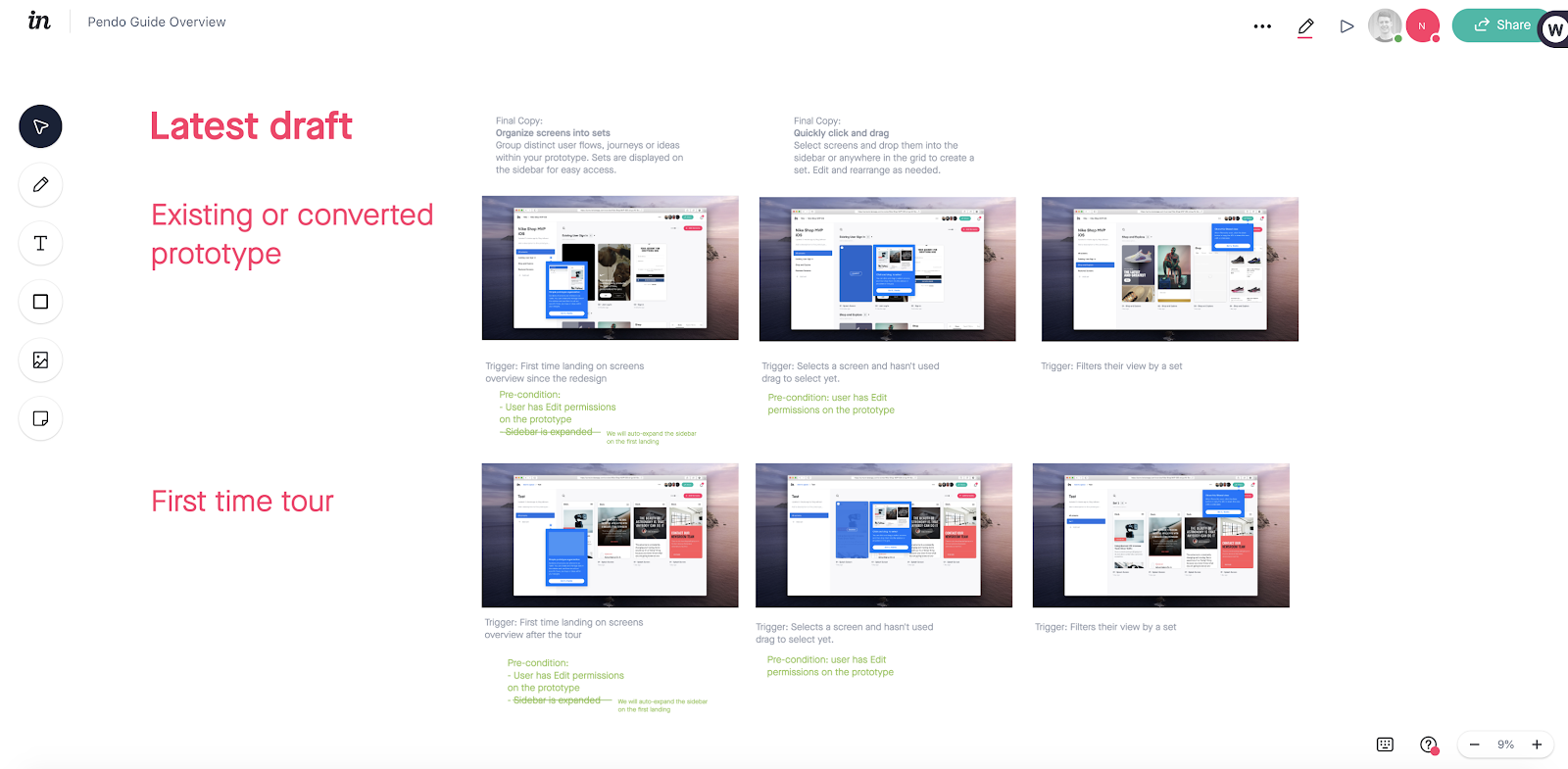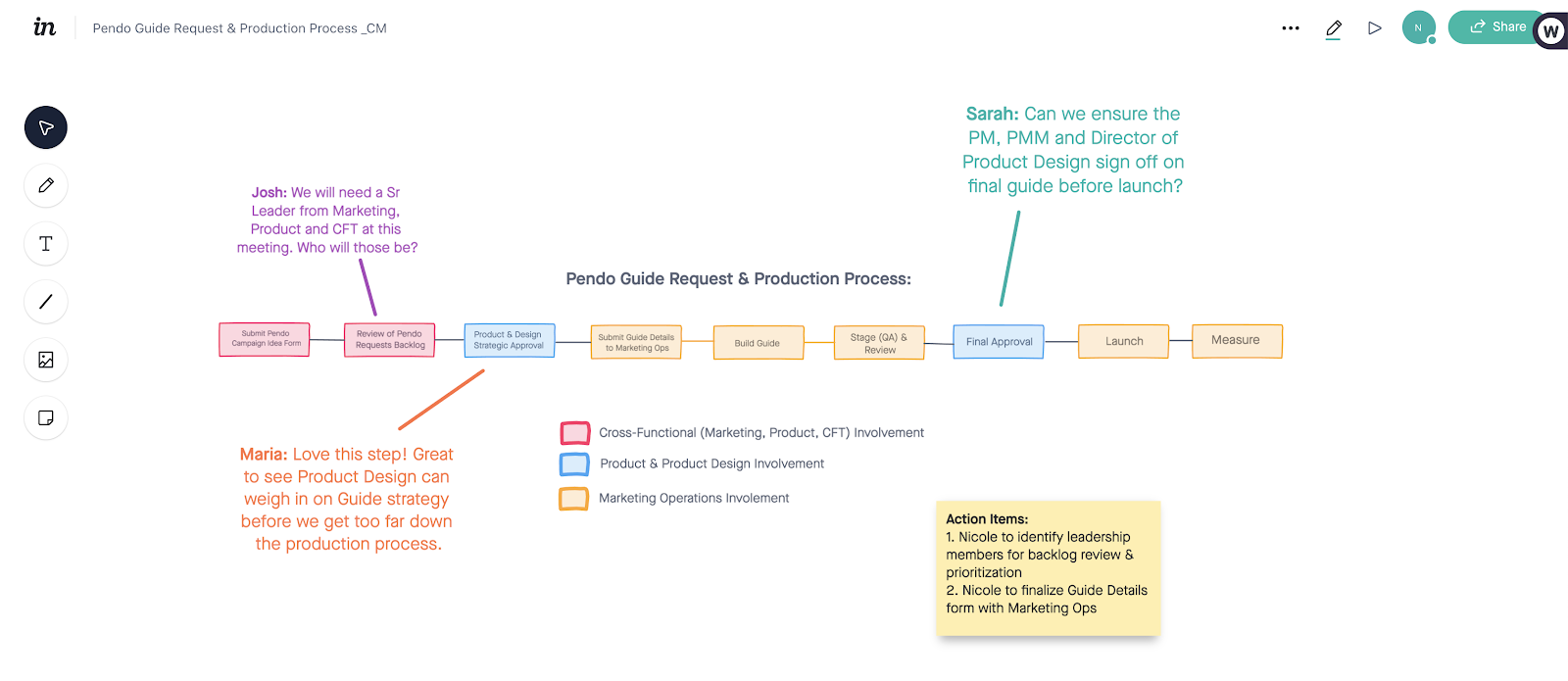If you’ve brought Pendo into your company, you know the benefits to expect: improved product adoption, customer retention and user onboarding, lower support ticket volume, faster innovation. But how do you get the rest of your organization moving toward those outcomes?
When the marketing team at InVision implemented Pendo, they got a little meta, using their own collaboration tool Freehand to obtain buy-in and facilitate cross-functional collaboration across the company. Not everyone understands how Pendo, with all the different guides, tooltips, and modals, can be pieced together in this holistic experience. InVision’s Freehand helped the team sell the value of Pendo internally in a way that brings it to life for people.
Freehand is a virtual whiteboard that allows teams to collaborate digitally in the same format they’re used to in a meeting room—with the added advantage of being able to save and share the boards, rather than having to take a photo of them and distribute it via text or email to the board or across departments.
Nicole Murphy, the senior director of lifecycle marketing at InVision, uses Freehand to storyboard what in-app guidance and onboarding flows would look like inside InVision’s applications, giving those who need to produce and approve the guides a chance to weigh in on their design prior to deployment. That’s proving critical to securing buy-in for Pendo across the company, and it’s a process Murphy says she’ll use moving forward with each guide deployment.

“Because our primary audience are designers, our design team is very conscious about what Pendo [guides] looks like in our product,” Murphy says. “Product teams want to ensure that Marketing isn’t going to go start sticking stuff all over their app, and they want to know that it’s not going to screw up the user experience and that it’s going to feel very seamless.”
The product team also wants to ensure they’ll be involved in a variety of ways throughout production to provide feedback and approval on the Pendo guides prior to releasing them to our users, Murphy says. The team also uses Freehand to map out and review the Pendo Guide approval process, which provided lots of reassurance to the product team.

Absent a way to illustrate it, Woulfe says Pendo (and other tools) can feel abstract to those who have never seen it before or experienced it firsthand. The first question the team knew they were likely to encounter from their own team leadership was “What is it going to look like?” Freehand helped bridge that gap, and in a much more dynamic way than anything that could have been achieved with something like a slide deck, Murphy says.
Having an eagle-eye view of how the Pendo guide flows will progress helps the team ensure they’re designing the optimal user experience, and make sure that everything matches their branding, Murphy says. If design or product doesn’t like the way something looks, or how the flow of a particular set of tooltip guides, they can write comments directly on the board and draw or make suggestions on how to improve it.
InVision is still in the early stages with Pendo. But once rolled out, Pendo guides and in-app messages will replace hard-coded tooltips in the app. The big selling point for InVision was the flexibility of Pendo guides, which can be changed in just minutes. That means different messaging targeted at specific segments of users can be tested much more quickly.
Murphy expects to use Pendo guides to help drive feature adoption after new releases. And, her team will revamp user onboarding with guide-based flows.
“Historically, we’ve primarily relied on email for new user onboarding. We’re now pairing that with some in-app guides to help users get past those last few steps,” Murphy says.
Pendo will also help InVision identify customers at risk of churn, revealing which users have not logged into the product over the last three months. They can use a combination of email and other outreach to get them back in the product, and then a series of Pendo guides meant to drive adoption, and ultimately retention.
“The idea there is to use email marketing to re-engage them, get them paying attention, and then drive them back into the product,” Murphy says. “And then once they’re there, we’ll use those step-by-step guides to try and get them to take some action.”